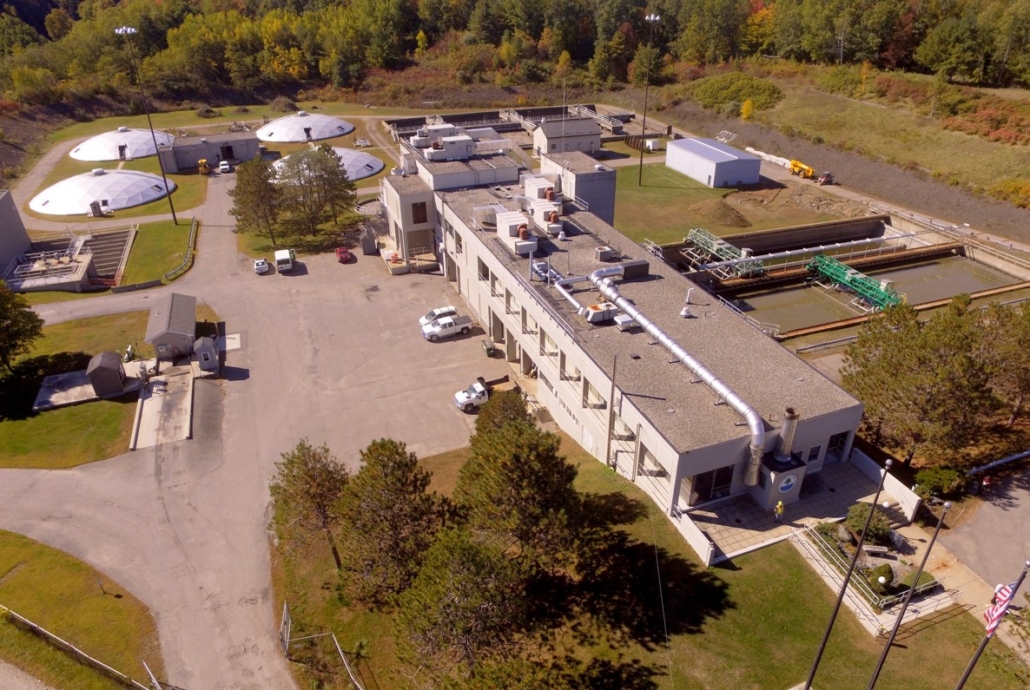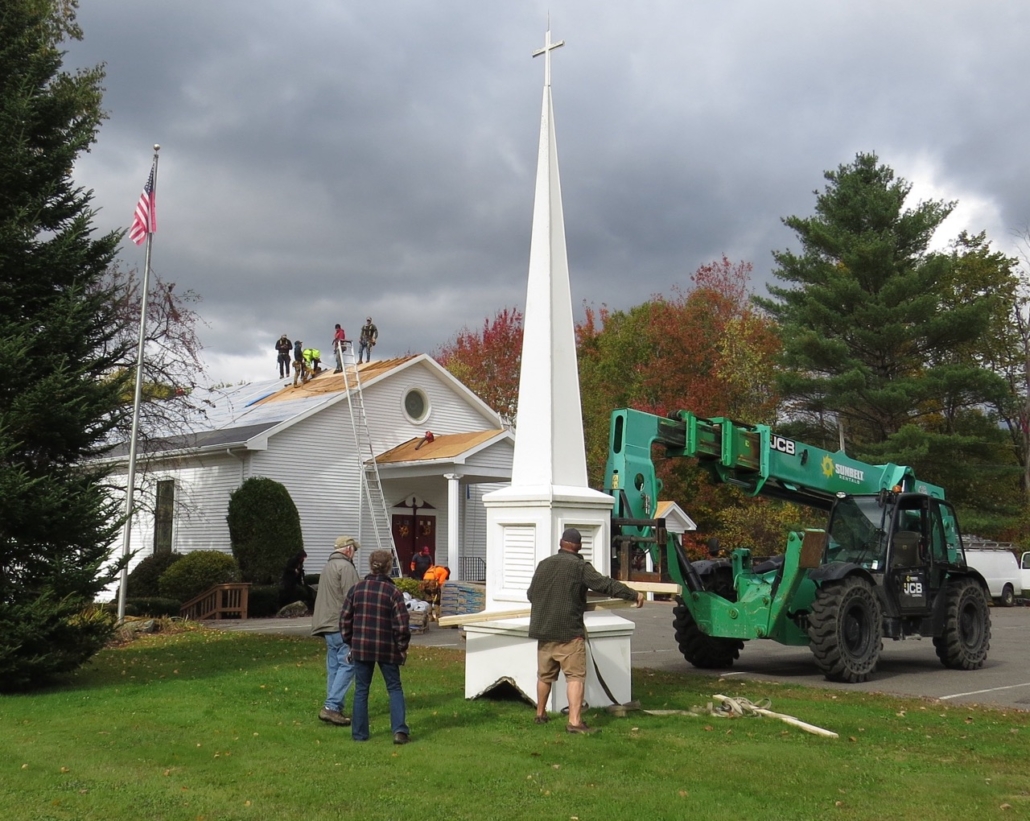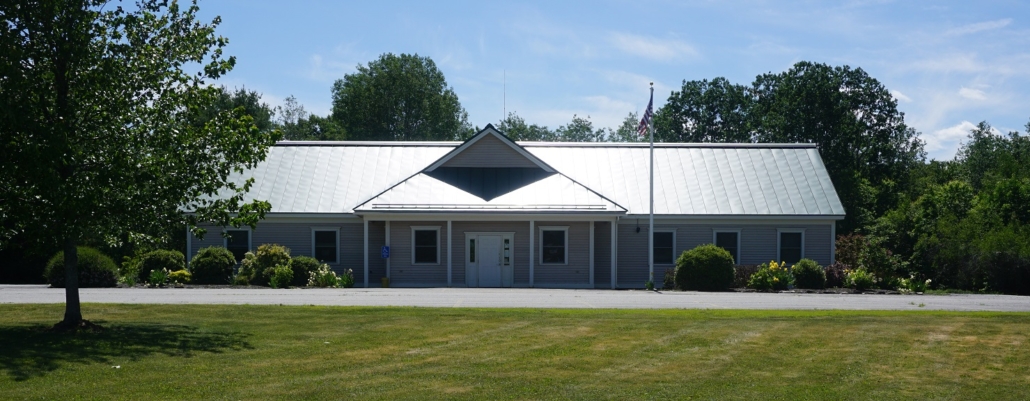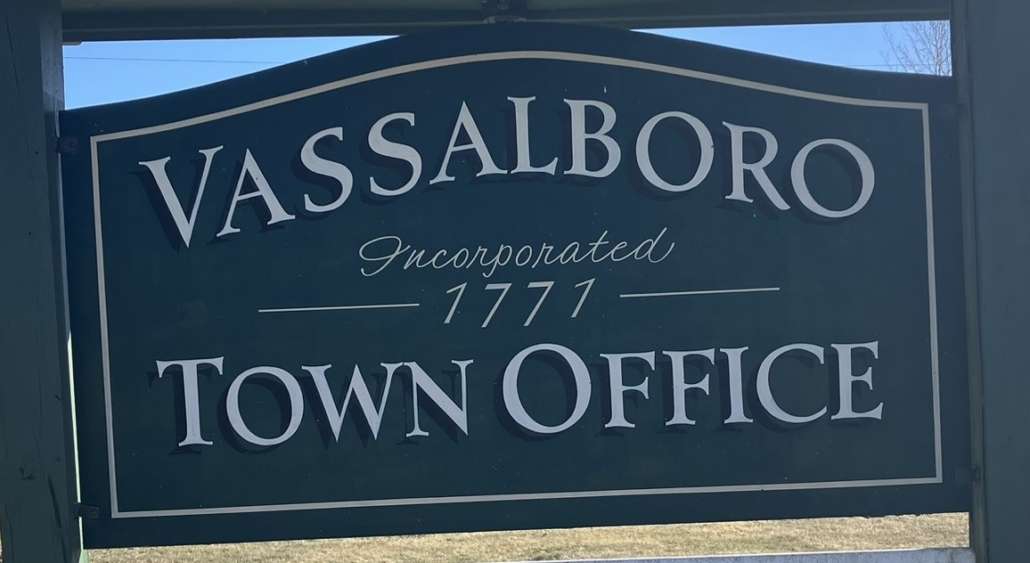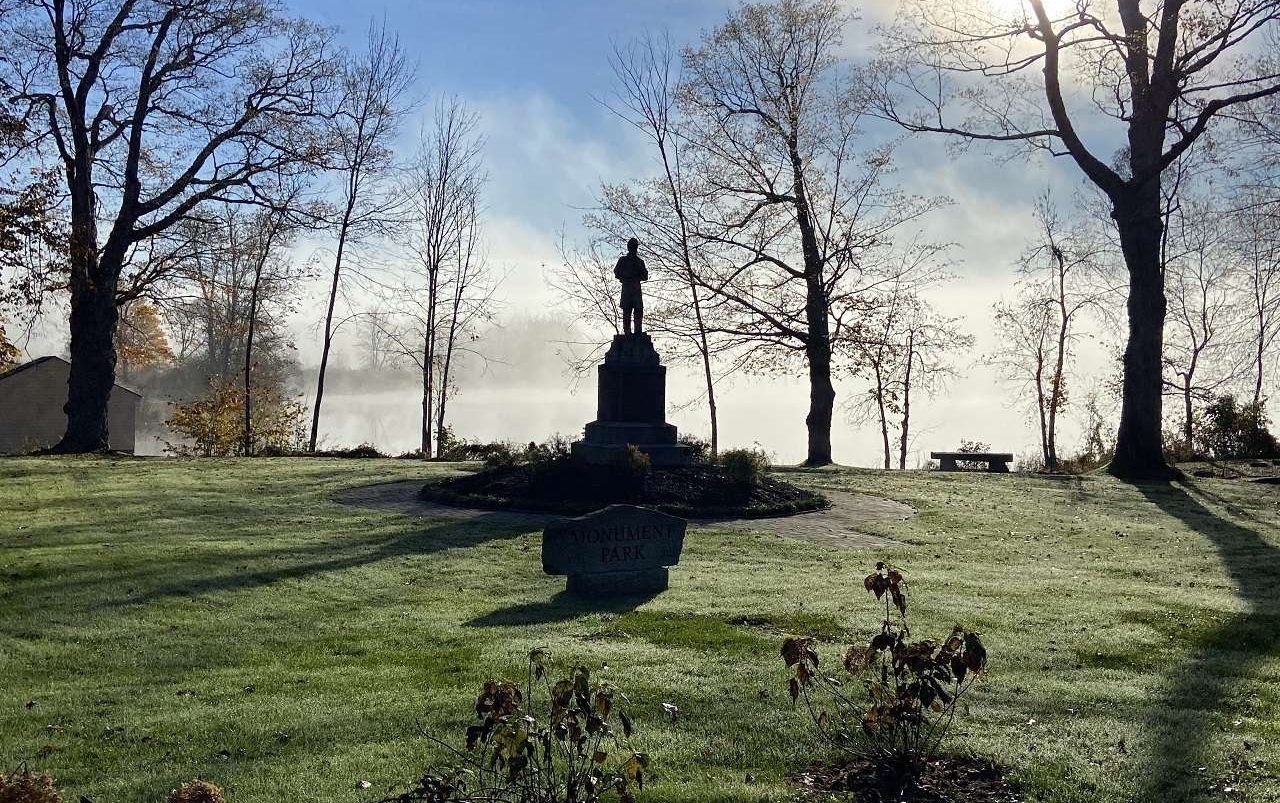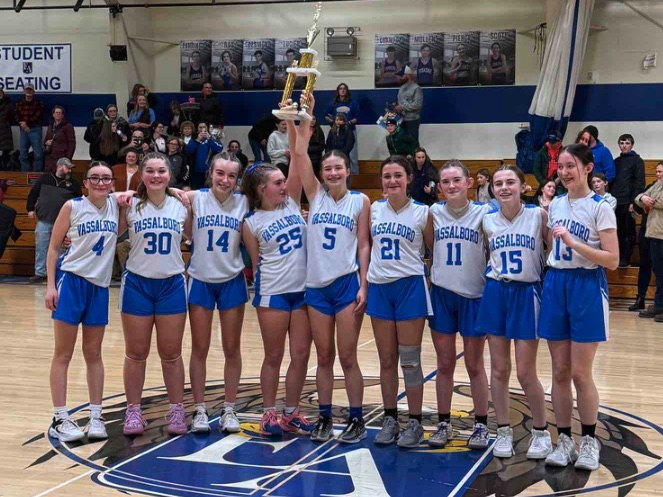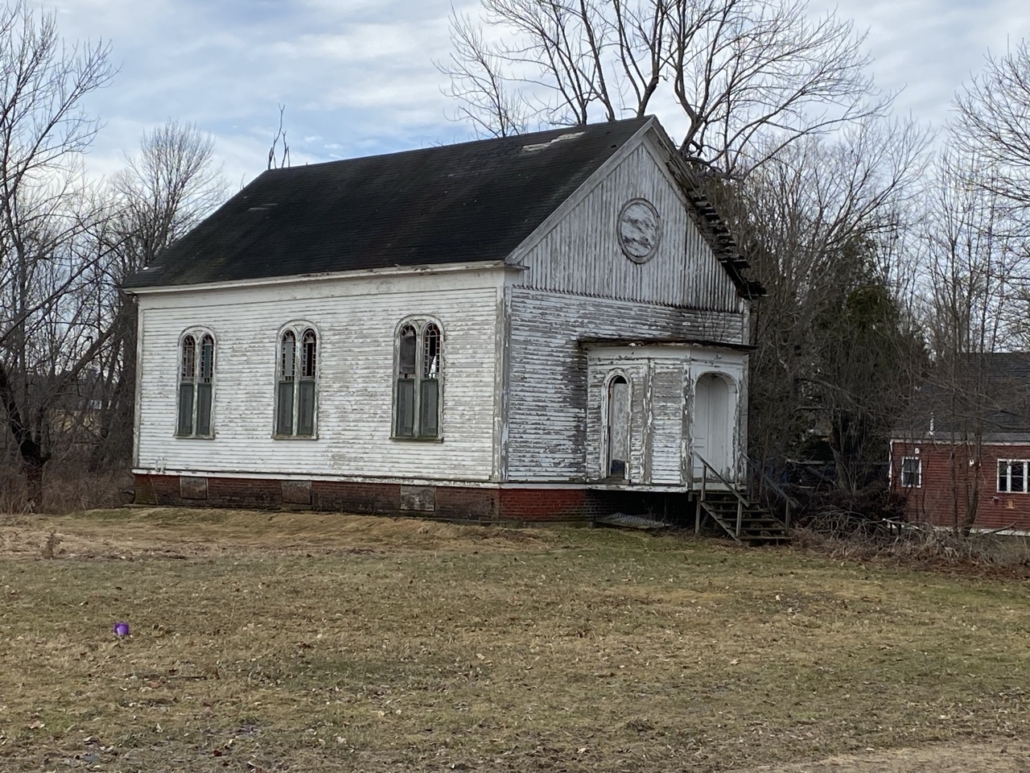
Getchell’s Corner church (Photo by Roland D. Hallee)
When Henry Kingsbury started his detailed description of the Town of Vassalboro in his 1892 Kennebec County history, he named six “post hamlets” and five “prominent localities.” Each post village was also a “manufacturing and mercantile” center, he said.
The first village he named was then called Vassalboro, or Vassalboro Corners, and had been first known as Getchell’s Corner or Corners, recognizing early settler John Getchell Sr., and his sons. Alternate spellings of Getchell include Getchel, Gatchell and Gatchel.
Kingsbury wrote that John Getchell bought the area where in 1892 the stores stood, and his sons “were scattered above and below, along the river road.”
(The river road was what is now a section of old Route 201, called Dunham Road, along the Kennebec. Current Route 201 is farther from the river; the old road roughly parallels it for about a mile. Dunham Road forms a four-way intersection with Station Hill Road, which ends at the river, and a short connector between old and new roads named Alpine Street.
Getchell sons Kingsbury named were Abial (or Abiel), who settled south of the blacksmith named Stephen Hanson, and John Jr., on the east bank of Southwick Brook. (Contemporary maps name neither of the small brooks that flow into the Kennebec north and south of the four corners.)
Kingsbury also mentioned a brook “back of Isaiah Gifford’s residence” that might have been Southwick Brook. He wrote that there was “evidence” the brook had been dammed and “tradition” telling of a pail factory and an ashery that Jacob Southwick had run.
(An ashery, Wikipedia says, “converts hardwood ashes into lye, potash, or pearlash,” all ingredients in soap-making.)
These factories must have been well above the Kennebec, because Kingsbury said Southwick ran a plaster mill downstream from them on the east – inland – side of the river road.
At the mouth of the brook, Kingsbury wrote, John Getchell’s sawmill had “gone into decay” before 1816. In 1816, Southwick and Prince Hopkins built a large tannery near the remains of the mill that apparently ran until Southwick died in 1855.
(Jacob Southwick’s brother, Dr. Edward Southwick, built a tannery in North Vassalboro that was in 1820 the largest in New England, according to both Kingsbury and Alma Pierce Robbins, in her 1971 Vassalboro history.)
There were two other tanneries at Getchell’s Corner, Thomas Frye’s “near Philip Hanson’s barn, in the rear of the hotel” and Thomas or Ebenezer Frye’s in an old currier’s shop on what was in 1892 George S. Smiley’s lot.
FamilySearch says Thomas and Ebenezer Frye or Fry were brothers, two of Joshua and Mary (Jones) Frye’s eight children born in Vassalboro between 1790 and 1806.
The Corner area hosted at least four 19th-century boot and shoe factories, Kingsbury said. Franklin D. Dunham started the biggest one about 1835, in a building that used to be in front of his 1892 house; when it burned, he moved into a building south of the post office, where the business ran until 1879 or 1880.
Dunham sometimes had as many as 100 people working in his factory. “He turned the business into the manufacture of brogans prior to and during the civil war,” Kingsbury wrote.
(Wikipedia defines a brogan as a heavy, ankle-high boot and says brogans or something similar were common military footwear, including for both Civil War armies.)
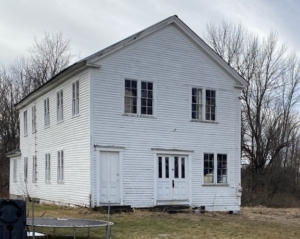
Getchell’s Corner Grange (Photo by Roland D. Hallee)
The other boot and/or shoe factories were owned by Joseph Estes, in the building that was in 1892 the Grange Hall, contemporaneously with Dunham and sometimes employing 50 hands; by Caleb Nichols, above his store; and by William Tarbell, in a building “on the green next north of the Congregational chapel” that had been moved and converted to a stable by 1892.
There were also at least two hat shops and one clock-maker (Oliver Brackett) at Getchell’s Corner.
By 1892, the major industry was the Portland Canning Company’s 1882 factory that processed primarily corn and apples – in 1890, “over 6,000 one-gallon cans of apples,” Kingsbury wrote.
Kingsbury did not date the first store in the settlement, which he said John Getchell Sr., ran. A “corner store” still operating in 1892 was built “early in the century as a double store,” shared by Joseph R. Abbott and Daniel Marshall. It went through a succession of owners, including Southwick and Hopkins, and Nichols in partnership with one of the Prescotts, Josiah or E. W.
The hotel mentioned above Kingsbury said was Vassalboro’s first. Daniel Marshall opened the building that became the hotel as a tavern “soon after the war of 1812,” and it went through a series of owners and was still open in 1892.
When daily stagecoaches between Augusta and Bangor ran through Vassalboro, the hotel was a stop where horses were changed, Kingsbury said.
“Tradition” said there was another hotel in a house that burned in 1830, “probably the house in which John Getchell had the first store.”
So many businesses required a local bank, Kingsbury wrote, and in the 1820s the Southwicks organized Negeumkeag Bank, which ran until around 1840, with Dr. Edward Southwick (Jacob’s brother, Kingsbury said) president. Kingsbury said the bank was capitalized at $50,000, and quoted a Jan. 1, 1829, state report that “showed its bills in circulation to be $51, 615.”
After the bank closed, Kingsbury said, the Southwicks moved “the queer old strap, wrought iron safe” to Burnham, where they ran a tannery.
The Getchell’s Corner post office opened April 1, 1796, Kingsbury said. The first postmaster was Jeremiah Fairfield; his successors to 1892 included Abial Getchell (March 25, 1818 – Jan. 14, 1826) and his son, Goodloe H. Getchell (Sept. 23, 1845 – March 2, 1852). Thomas Frye served as postmaster for two short periods in the early 1840s and early 1850s.
Writing in 1971, Robbins said there had been “many changes in both buildings and location,” but there was still a post office at Vassalboro “now more familiarly called Getchell’s Corner,” as there is in March 2025.
Robbins wrote that Miss A. Howard founded Vassalboro Academy, a school for young ladies, at “Vassalboro Corner” in April 1837. Kingsbury said the school building was “used for religious as well as secular instruction.” The Methodists bought it in 1868, after meeting there for several years, and made it into a Methodist church. Robbins said it remained in use “until the fire in 1886 [probably an error for 1896; see below].”
The first Vassalboro Masonic Lodge was organized at Getchell’s Corner in June 1827; it moved to North Vassalboro in 1870. After the Civil War, Kingsbury described a second Masonic Lodge, Negeumkeag, established in 1872, which in 1892 “owns its hall and numbers forty-six members.”
Kennebec Lodge, I.O.O.F. (International Order of Odd Fellows) started in December 1889, using the Masonic Hall.
Oak Grove Grange, founded in North Vassalboro in May 1875, moved to Getchell’s Corner (date unspecified) and in 1892 had its hall “a few rods south of the Congregational chapel,” with a store the Grangers had opened in November, 1889.
Houses mingled with the other buildings, and farms surrounded the business and residential center. The 1856 map of Vassalboro shows more than three dozen buildings at Getchell’s Corner; by 1879, there were fewer, but the area was still designated Vassalboro Corner.
In 1850, Robbins said, the railroad was run along the east side of the Kennebec from Augusta to Winslow, mostly at first to serve John D. Lang’s woolen mill, in North Vassalboro. By 1861, passengers as well as freight were important; Robbins wrote of residents in horse-drawn buggies meeting summer people arriving at the Riverside and Vassalboro (Getchell’s Corner) stations.
According to Robbins, the railroad may have been the village’s undoing. “It was never proved without a doubt that the sparks from the Maine Central engines set the fire that burned nearly the whole little village of Getchell’s Corner,” she wrote.
This event was in 1896 – Robbins gave no exact date. Losses included the hotel and post office, businesses and stores and about 30 houses. Getchell’s Corner never recovered.
Captain John Getchell Sr.
The FamilySearch website says Capt. John Getchell, Sr., was born in South Berwick on Feb. 23, 1747 (Ancestry says around 1741). On Nov. 21, 1766, he married Sarah Cloutman (1745 or 1746 – 1835) in Kennebec (County?); the couple had at least four sons and a daughter. He died Oct. 14, 1818, in Vassalboro.
The sons, according to this source, were William (1773 – ?); John Jr. (1777 – 1853); Abiel J. (1779 – 1855); and Josiah (1796 – 1896). Daughter Susan was born in 1782 and died in 1815.
FamilySearch has little information about William.
John Jr. was born in Vassalboro; he married Elizabeth Bunker on April 5, 1795, in Vassalboro, and they had at least five daughters between 1797 and 1814. He is buried in Vassalboro.
Abiel married Letitia Harwood on Jan. 20, 1802. Three of their eight children, Captain John and Sarah’s grandchildren, stayed in Vassalboro, to wit:
— Goodloe Howard Getchell, born Nov. 23, 1802, in Vassalboro and died there in 1875.
— Mary Ann, born in Vassalboro July 3, 1804, married Samuel Gibson and died in Vassalboro, aged 99.
— Abiel John, born in Wiscasset in 1814, but lived in Vassalboro in 1850 and was buried there after his death in 1861 (as was his widow, the former Ann Plummer, who died Jan. 23, 1906).
Of Abiel and Letitia’s other children, Horatio was born April 22, 1807, and died July 24 the same year; Lucretia Harwood, married in 1841, was in Iowa in 1870 and died in 1888 in Arkansas; Alexander Hamilton lived in Wales, Monmouth and Greene; Hiram was born in Monmouth and later lived (and died) in Brownfield; and Hannah Margarete Cochran was born in Sebec and died there in 1861.
Josiah Getchell, Captain John and Sarah’s youngest son, was born in Brunswick, FamilySearch says, and seems to have had no Vassalboro connection.
WikiTree offers a completely different John Getchell, also called Gatchell and Getceell, born in Scarboro April 25, 1719. On Nov. 7, 1742, this John Getchell married Mary Barbour, of Brunswick. He served in the Revolutionary War.
John and Mary’s two daughters and four sons (Dorcas, Samuel, John, Mary, Hugh and Robert) were born between February 1743 and September 1754. WikiTree gives no birthplaces.
It does, however, say that on June 23, 1768, Getchell bought from the Kennebec Proprietors land on the east side of the Kennebec (“in what is now known as Sidney” – an error, the Sidney that separated from Vassalboro on Jan. 30, 1792, was and is on the west side).
WikiTree continues about this John Getchell: “He held many important town offices in Vassalboro, being the largest land-owner there, and residing at what is still known as Getchell’s Corner.”
To add to the confusion, some maps locate Getchell’s Corner farther south in Vassalboro, near Taber Hill; and on-line sources offer an Elihu or Eliha Getchell, Sr. (1766 -1838), who (according to FamilySearch) was born in Berwick; married Mary Savage in 1787, in Hallowell, and had at least four sons and four daughters; lived in Vassalboro “for about 30 years”; and died in Medford. The Ancestry website connects this Getchell family with Tabor (Ancestry’s spelling) Hill in Vassalboro.
Main sources:
Kingsbury, Henry D., ed., Illustrated History of Kennebec County Maine 1625-1892 (1892).
Robbins, Alma Pierce, History of Vassalborough Maine 1771 1971 n.d. (1971)
Websites, miscellaneous.
CORRECTION: This article has corrected a reference (third paragraph) from the print edition which referred to Route 202 when it should have referred to Route 201 instead. Thank you to the reader who caught the error.


